 Facebook
Facebook
 X
X
 Instagram
Instagram
 TikTok
TikTok
 Youtube
Youtube
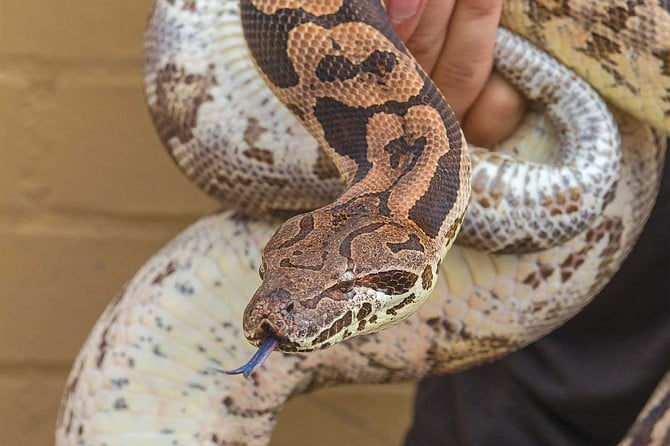
To hold an anaconda, it’s best to spread your hands out like spatulas and let the snake lie there, feeling supported. If the serpent doesn’t feel buoyed in your hands, it will squirm and droop like it’s upside down, which, from its spatial orientation, it is. The snake has a belly—the lighter colored half underneath—and the belly wants to be down, if not on the ground, then grounded. Otherwise, it curls and twists, not because it has it in for you, but because the creature is trying to get away, that is, out of midair and back to the security of its burrow or enclosure. Once you brace the writhing beast from below, snake and handler calm down—find, as it were, common ground.
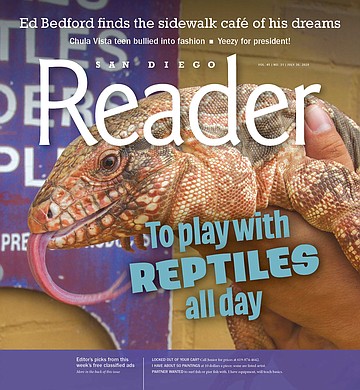
I’m fascinated by this snake-human interaction. It’s early 2020, the coronavirus has been uncaged in Wuhan and headed for Europe, and I’m agog at the many ways we approach these coiling marvels. By “we,” I mean my fellow southern Californians, those, like me, whose alarm-meters ping at the sight of anything thrashing about and those whose delight in serpents is irrepressible — both sorts mingling in a sky-high ceilinged arena for the Reptilian Nation Expo at the Del Mar Fairgrounds.
It may be a generational thing—a millennial thing—that teens, tweeners, and kids pack the hall; apparently, they love shopping, buying, owning, housing, raising, and holding up (from below) the very snakes and other reptiles/amphibians at which their pulled-along grandparents recoil.
A sixteen-year-old, his forehead tangled with a waggish mop of black hair, asks a snake dealer if he might examine a small pattern-honed ball python. (Much more on these captive breeds in a minute.) Clearly a devotee, he cradles the snake in his open hands and brings it close to his chest, then to his face, his eyes wide, smiling possessively. He slows his hand motions to the pace of the curious, near-sighted snake. It’s not quite two feet long, very delicate, the color of scrambled eggs with inky marks like cracked asphalt after an earthquake. An animated abstract painting.

Then, with choirboy affection, he rubs a finger under the snake’s chin, and the python, its head/neck still in the S-curve (as if to strike), seems to bliss out, kittenish, at the tender touch. The teenager says to his group of friends watching him, “When I have money and I don’t live in a mobile home anymore, I’m going to buy one of these guys.”
A young girl, daughter of a father who tells me they “already have eleven ball pythons at home, in buckets,” shows off her latest purchase — a coiled constrictor resting on a damp paper towel inside an eight-inch wide plastic container. Its mottled markings alternate a vanilla white and a banana cream — sort of like a yogurt swirl. The dad says, “OK, honey, now we’ve got a dozen,” and the daughter looks pleased, as if she’s been given a diary in which to record her secret thoughts.
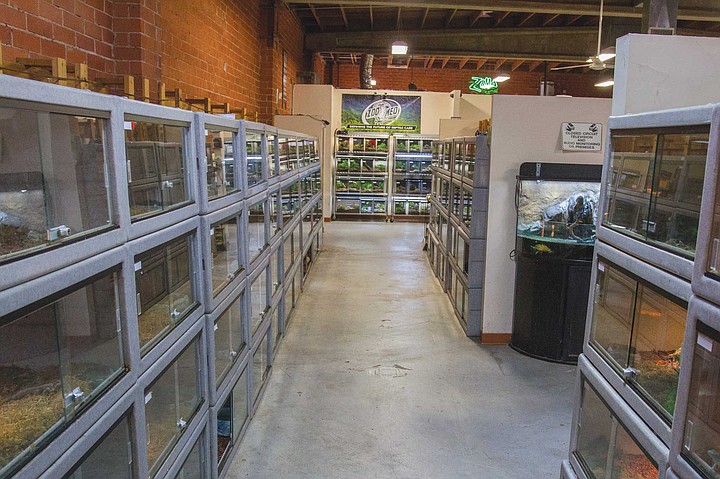
(Fun facts: In the last 25 years, captive breeders have engineered 5000 patterns and colors for the ball python species. The snake is motion-named because that’s its defense: tucking its wedge head in, the python spirals its body tight when it’s stressed or afraid, which, owing to all the Expo fuss, must be most of the time.)
I pass hundreds of deli cups of ball pythons as well as hundreds of clear plastic boxes with outré species like the New Guinea Red-Eyed Croc Skink, six inches long with a spike-stippled back; and the male Desert Iguana, of local renown, the lizard that does female-inviting pushups. (In the legitimate commercial snake trade, no venomous snakes are sold.) Serpents slumbering in their containers seem okeydokey under heat lamps, flicking their tongues at their lids: Where am I? Orlando, Memphis, Anaheim?
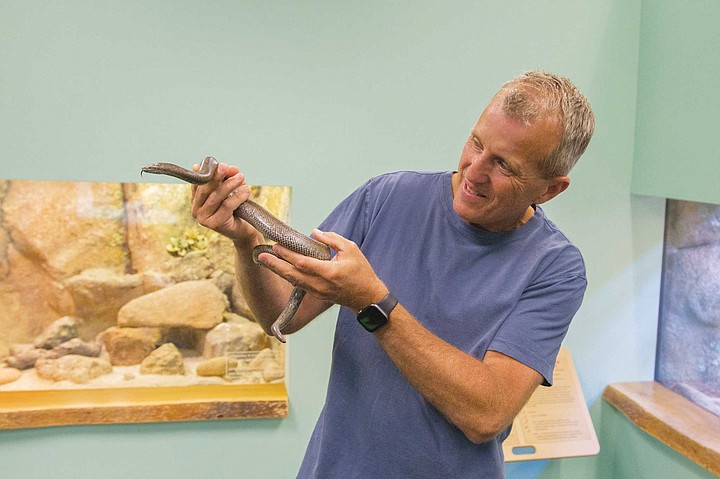
It’s easy to anthropomorphize snakes, especially when such human devotion suggests cuddliness, adoption, and bonding. In our new stay-at-home era, these exotics have seized the acquisitive imagination of Americans, our new national pets. As the trend preys on Mom and Dad — owning a reptile is a parental signal of a kid’s maturity — living room terraria and their horde may surpass zoos in the preservation and cultivation of this class of animals, some 12,000 species. Even so, collectible creepers such as the Sulcata Tortoise (lives to 100) and the Hermit Crab (lives to 10) seem as indifferent to us as anything else we try and domesticate.
From Costa Rica to a deli cup
I’m escorted through this faunal miscellany of Assassin Bugs, Tanzanian Tailless Scorpions, and Baby Nile Monitors by Loren Leigh, owner of LLL Reptiles (flagship store in Escondido) and a major exhibitor at the Reptile Expo. Three of Leigh’s seven regional stores, where he sells all kinds of scaly critters, are in Southern California. In the pre-viral years, he displayed his animals and product lines at 35 reptile expos across the country. “Sixty-five percent of people in the U.S. own a dog,” he says. “Nine percent own reptiles.” It’s not huge —not yet — but it’s more than doubled in the last decade.
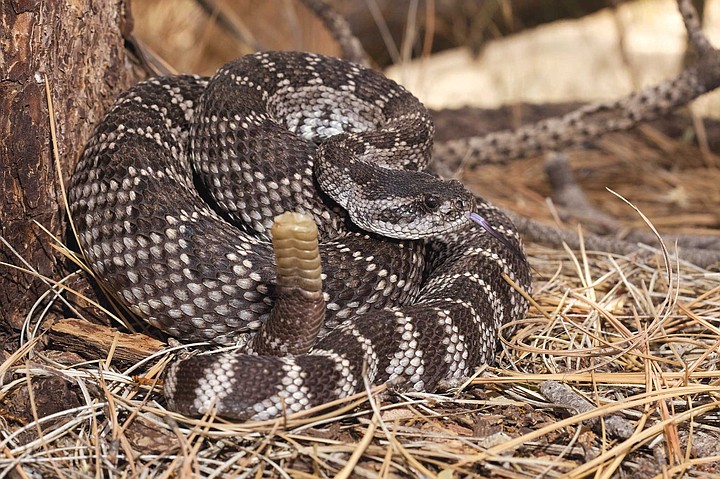
Leigh, his talk spiced with genial humor, is quick to point out that “the trade” includes snakes, lizards (fan favorite: the bearded dragon), salamanders, frogs, toads, turtles, tortoises, and arachnids (spider idol: tarantulas). Essentially, planetary ground dwellers. The study of these animals is herpetology, from the Greek herpo, to creep or crawl. Which, metaphorically speaking, suggests surprise, stealth, and, with the addition of witches, conjuration and the dark arts: eye of newt, toe of frog, adder’s fork, lizard’s leg.
The online market, he says, is unquenchable. “Reptiles are one of the few animals we can ship. You can’t just go to FedEx and package a dog. But these reptiles can be transported around in containers. With a little food and water, they’re fine.” (Reptile prices range from $50 to $4500; the sky-high tags attach to the rarest and the prettiest.)
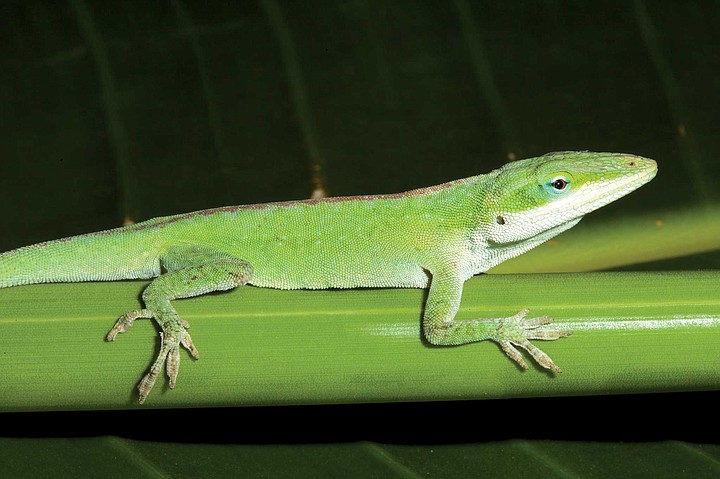
The Del Mar Expo is a midsize retail fair on the exhibition highway. Events nationwide and worldwide number in the thousands. In Southern California, the Reptile Nation Expo arrives spring and fall in Del Mar, as well as in Ontario, Long Beach, and San Bernardino. (The largest trade event is in Chicago, a Macedonian army of 500 vendors, replete with many hundreds of species.) Leigh says of breeders, “We used to be backroom hobbyists, now we’re businesses.” His tabled array carries all the accoutrements for both intimate and massive terraria, with such products as fake hollowed-out logs to burrow in, lots of moss, and the ubiquitous touch of the macabre, a (plastic) human skull.
Temecula breeder Michael Roscoe, new to the pet trade, is already specializing in “high-end ball pythons and boas and lizards.” Another hobbyist turned entrepreneur, he travels overseas a lot, often to Germany. To transport his product, he must “individually pack them with heat, cold, whatever the journey demands. They need insulated boxes in line with the airlines, which require permits and health certificates and veterinary inspections, as do U.S. Fish and Wildlife, and the U.S.D.A.” He laughs heartily at the onerous regulations. Profits, however, are not his prime motivator. “I get to play with reptiles all day.”
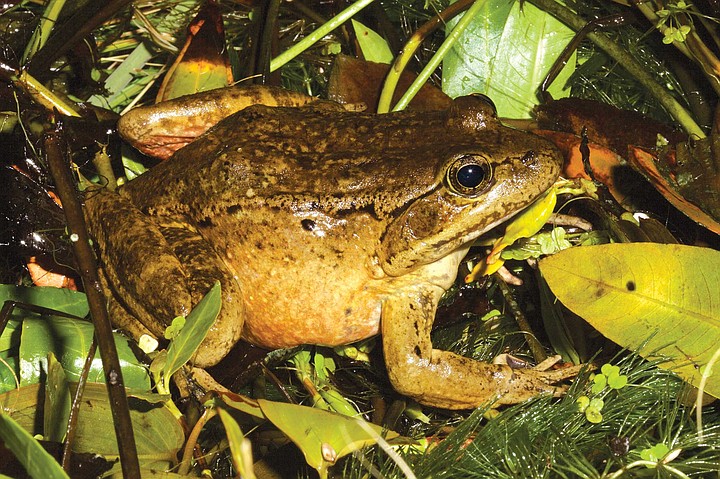
Leigh, 42, has fulfilled his childhood passion for reptiles. He wants to extend the love to close-knit families. “Look around,” he says. “Young families, kids, teenagers. They used to be ‘backroom, in-the-garage, weird-dad’ animals. Now they’re in the living room, Mom’s into it, it’s a teaching tool. It’s replaced the hamster.”
The young treasure “the oddity of it all,” he says, the tinkerer’s shop of gemlike shapes, textures, colors. The chameleon swivels its eyes to see in front of and behind itself, independently, too, a companionable sleuth or sidekick for a child. (Capitalizing on chameleon cuteness is Disney’s Pascal in Tangled.)
One industry motivator is that millennials worry far less about the crawling horde than their parents and grandparents. In addition, unlike the extroverted dog or horse, reptiles induce a science-fiction-like awe, “beings from another world.” Leigh says. And while ancient myths of reptiles stalking helpless humans abound (in the Garden of Eden, the Serpent is Satan transmogrified), those myths dissolve once the animals are handled and studied.
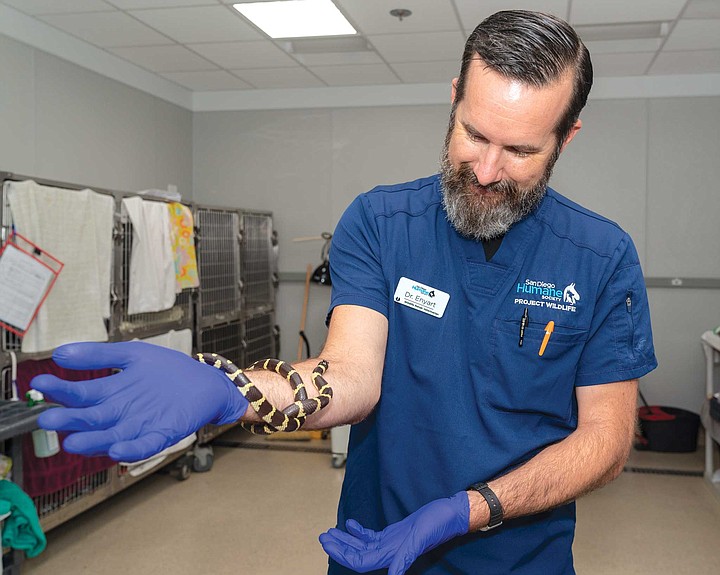
The biggest motivator in reptile growth, according to Leigh, is that families treat the acquired animal like a companion. “For us, the fish tank of 50 years ago is now the snake tank.” Recently, a buyer thanked him for selling him “Lorenzo.” “Who is ‘Lorenzo’?” Leigh asked. It’s a tortoise, with a 50-year lifespan, who teaches his kids responsibility: he must be fed, kept clean, engaged, and turtle-sat during family vacations.
“Most snakes do not get big,” Leigh says. “Most snakes are not harmful; most snakes are wary of us, and they’re defensive. Look around. People are holding monitor lizards without an ounce of dread.” He says wary “parents and their 1975-fear-of-everything-reptile” label any monitor “a Komodo dragon,” ready to rip your face off. Kids think “just the opposite — my reptilian friend.”
Reptile study and preservation
Strolling through the San Diego Natural History Museum’s Living Lab exhibition (caged live animals) with longtime curator of herpetology Brad Hollingsworth, I learn that after years spent watching visitors, he calls crawly creatures the “unlovables. A herpetologist deals with people’s negative perceptions of a venomous snake, a scaly lizard, a slimy frog. ‘Oh, they’re so prehistoric’” — like that’s a bad thing.
The tag “unlovable” suggests conflict between those who treasure these animals and those who loathe them. To be clear, the Natural History Museum does no breeding; its reptilian/amphibian focus is local habitats. Hollingsworth says, “We hunt, we trap, we count reptiles” in the Southern California and northern Baja wild. The museum exhibits very few live species.
When it comes to snakes, the serpents with the greatest and grimmest notoriety are rattlesnakes. The public’s response to these triangle-headed beasts is fear of getting bit. But that fear regularly accompanies disrespect and ignorance, Hollingsworth says, even the desire to “chop off its head! How about just keeping our distance when we encounter a rattler?” he asks. “As midlevel predators, they are crucial to regional ecosystems.” They are food for coyotes and they control rodents. They have their place, though we are hesitant to let them have it.
Reptile decline is real. Many species have been overrun by human rapacity, while few have thrived. Take a couple of frog species. Who knew how fierce their competition has been? A century ago, the American bullfrog overtook local ponds. How? Served for dinner in “frog-leg restaurants,” a few hopped out of the pot, down the alley, and into local ponds and estuaries. They flourished because they are insatiable, “ferocious predators,” Hollingsworth says. “Herps eating herps.” Even today, these invaders are still “displacing native frogs, turtles, and garter snakes.”
One of the more defenseless of its genus — rana — has been the native California Red-Legged frog. This frog has “massively declined” due to the American bullfrog’s ravaging. Hollingsworth and his colleague’s prime mission, mostly in northern Baja, is to protect the Red-Legged from invasive plants and predators, and, if possible, restore their natural habitats, giving the amphibian a chance at a comeback. So far, it’s a mild success, as their numbers, according to the latest count at the Nat website, hover around 200.
The wild bunch and the pet trade
Hollingsworth helps me nail down two approaches to herpetology. One is the reptile in the wild (its flora habitat), which the museum studies and catalogs, and the other is the pet trade in reptiles (its breeding facility and living-room habitats), which has become a thousand times more plentiful. Regarding the former, Hollingsworth describes the newest research tool: digital photography. Such documentation — leaving the critters in situ — is a hands-off way to “collect” reptiles in the wild. Photographers post their shutter-finds and the breadth of their discoveries on the website I-Naturalist.
Hollingsworth is still processing how to think about the role of herp collectors in a world losing so many amphibian and reptile native spaces. (In the United States, 80 percent of the wetlands that once existed no longer do.) He says, “All pet collecting has its purpose and place in educating people and letting them fall in love with a reptile’s intimate nature — especially when you’re keeping one at home. For me, [those reptiles are] far removed from natural habitats and the wild.”
What’s more, the place of reptiles in our world is not just a species concern but an environmental one. He partitions the divide like so: human-made environments for reptiles, manufactured and decentralized and temperature-controlled; and natural environments, where diversity reigns, where animals are (somewhat) protected from two-legged conquest, and where islands of preservation are now de rigueur.
There’s a split — the tension weighing on animals more than on us — between public and private, between the wild and the zoo, between a species’ right to self-determination and a human right to species-ownership. (Rights we extend to ourselves can be, but seldom are, extended to animals.)
As I press Hollingsworth about the pet trade, he is hesitant to “say anything ill about people.” He’s curious about the amateur breeders and their intentions. To what degree “does the selling of [captive] animals help wild animals?” He’s not sure what the answer is. But there’s tension. For him, one division occurs in the desert between the off-road vehicle community and conservationists. Both groups love everything about the desert — the camping, the clear night skies, the scenery, the wildlife, the vegetation — except the off-roaders disrupt the fragile topsoil by riding across the land.
With pets, there’s a similar divergence. He notes that people “take care of the animals, the same way I do.” But what happens when they are bred and sold? “What’s the motivation there? To make money or preserve them? I don’t know of any case where they’re contributing to their preservation.”
And yet, Hollingsworth wants it understood that he believes the pet trade, like digital photography, will ultimately make reptile lovers love reptiles in the wild as much as they do in deli cups. “The difference is one of nuance — and of intention.”
If private breeders wanted to help the California Red-Legged frog, they would breed and reintroduce the species into the wild scientifically. One can’t just dump an endangered animal into a habitat and hope it will repopulate their numbers. “Every introduced species will have a new genetic footprint.” That new “invader” can easily, despite the good intentions of its advocates, “significantly alter an ecosystem”—what’s been in a pond or under a rock for hundreds or thousands of years.
One invasive reptile that got loose of late is the Green Anole. He says that too many of them were “well-embedded in the pet trade,” as “feeder lizards” for snakes. “Our worry is that the anole will” shake up the natural order. So far, they are staying pretty much “within landscaped yards,” but that could change.
Perhaps the story here is that the pet trade and the museum trade, whose paths once paralleled, are now intersecting. The more captive breeds thrive in captivity and the more they escape, accidentally or on purpose, the more stress is put upon the natives. The risk is that nature will become zoo-like, composed of human preferences. Exhibit A: the Burmese python overrunning the wetlands of Florida.
Pandemic pet sales spike
In early March, pandemic-chastened, I cancel several in-person interviews and on-site tours of animal labs, critter mélanges, and field walks looking for herps. Only in late May do I get back on the pony—and even then, only by phone.
Loren Leigh of LLL Reptiles describes his facility in San Marcos. He estimates he has 2000 slots for 700 species of reptiles and amphibians, from common to exotic, which he’s breeding. The animals are racked on shelves, in plastic pullout bins, “drawered like a dresser.” Heating and lighting elements are built into each drawer. For the bigger animals, he uses macrobins, four by four feet, lightweight, transportable.
Reptile breeders are, to say the least, heavily hands-on — cleaning and changing enclosures, prepping food and feeding, selling and shipping to individuals or for expos, and overseeing the seasonal breeding process, which, under captive conditions, follows natural contours of winter hibernation, warm-weather fattening, mating rituals, then letting females gestate and give birth, months later.
Like Noah, Leigh pairs reptile species. “We’re looking to take a trait of this animal,” he says, “and breed it to a trait with another animal — to create new and exciting patterns and colors.” Such is genetic breeding: mate a lizard with a stripe on its back to another lizard with little pink feet. Breeding answers the question, can those traits be combined? Often the answer is yes.
Perhaps surprisingly, in the pandemic, reptile sales are spiking, not decreasing. Why? Leigh says, “We’re recession-proof because people turn homeward during crises, and we’re one of the few industries that’s still mail-order.” For the past three months, pet stores were deemed “essential.” Pets need food (from crickets to frozen rodents), vet services, litter, lighting, and enclosures.
“The government’s not going to ask you get rid of your pet in a pandemic,” Leigh says. “We’re essential to help maintain the livelihood of the animals you own.”
Leigh says the pet store is really about human well-being. People want “to hang out, linger, spend time with animals.” When schools closed, parents brought their kids in. “It’s a safe place, like a zoo; people left home and came in to buy a pet. During a pandemic, they could,” however briefly, “escape it all.”
What of the worry that animals, especially from international breeders, may carry zoonotic viruses or crop-destroying bugs? He says “it’s nothing new.” Pandemics always ratchet up fears of disease transmission via vertebrates, and pet traders get blamed for the latest event. Just like avocados or lobsters from other countries, animals are screened and quarantined as necessary at one of four U.S. ports of entry, in facilities run by the Fish and Wildlife Service.
Of his industry, Leigh says, “we’re not buying animals from these people,” that is, “animals from the wild, crammed into cages and sold in food markets where bacteria are exchanged. Unfortunately, reptiles are considered wildlife worldwide; they’re not protected like domestics, your hamsters and your dogs. So, we fall into the same category of import/export as a food item would.”
One way to keep the pet trade safe and viable is to keep it in-country. Thus, captive breeding continues to grow. At the Del Mar Expo, I spied many creatures — chameleons whose skin changes color with moods and tarantulas who, when riled, flick urticating hairs at predators — that are “native” to Central America or Africa, but not necessarily imported. They are, so the salespeople told me, bred here.
Finally, I wanted to know what Leigh thought of Brad Hollingsworth’s suspicions that pet dealers and owners bear some responsibility for the growing number of nonnative species, released into and proliferating in our habitats — for example, the American bullfrog in the West and the Burmese python in Florida.
Leigh says he’s dumbfounded that any dealer would let a Burmese python loose when the owner/breeder “could make $20,000 selling that snake to a consumer.” If a hurricane hits a zoo or towns are overrun by feral cats, the media sentence pet owners, sellers, and transporters to the gallows. “It’s unfair.” As for the American bullfrog, he faults the Fish and Wildlife Service for releasing the frog a century ago “as pest control. That had nothing to do with the escape of pet bullfrogs.”
Animals of all stripes, whether Ruth’s Chris Angus beef or Best in Show at Madison Square Garden, multiply exponentially under the human custom to have and to hold, to love and to groom, to sequester and to eat. For better and worse, there is a toll: 70 billion nonhuman creatures are “processed” (slaughtered) every year for human and animal consumption. I’ve never been able to fathom the irony that what defines our metabolic sustainability is what we love and what we eat.
Wild reptile rehab
A final post-Covid phone visit is with the San Diego Humane Society’s Dr. Jon Enyart, veterinary director of the Pilar and Chuck Bahde Wildlife Center. The practice, which includes a hospital and “care rooms” for reptiles, birds, and mammals, rehabs some 12,000 animals yearly, two-thirds of which are avian, followed by large and small mammals. Only about one percent, 100 or so, are reptiles and amphibians.
With the latter, he deals exclusively with local natives, none from the pet trade. Those “companion animals,” dogs and cats, turtles and rabbits — and ball pythons — are rehabbed, if necessary, and housed in the Humane Society’s shelter as “stray holds.” The hope, often redeemed, is that their guardians will retrieve and handle them more responsibly. If not, the animals “should be adopted out,” Enyart says.
Ninety percent of the reptiles he treats consist of four species: the Pacific Gopher Snake, the California Kingsnake, the Southern Alligator Lizard, and the Western Fence Lizard. (Injured rattlesnakes are sent to a separate facility, in part, because of their venomousness.) Denizens of our canyons and mesas are triaged for trauma — sliced by weedwhackers, hit by cars, caught in garden netting or on glue traps. When a reptile’s scales are lacerated, Enyart sews them up.
Reptiles make lousy patients, he says. Slow healers, they need to be sedated and often show scant verve even while on the mend. They miss their digs too much. The endgame is to release them within a mile of where they were rescued, away from nets and traps. Enyart also says the success rate nationwide for rehabbing and releasing all native wildlife is about 31 percent, meaning (sad to say) seven out of ten don’t make it.


To hold an anaconda, it’s best to spread your hands out like spatulas and let the snake lie there, feeling supported. If the serpent doesn’t feel buoyed in your hands, it will squirm and droop like it’s upside down, which, from its spatial orientation, it is. The snake has a belly—the lighter colored half underneath—and the belly wants to be down, if not on the ground, then grounded. Otherwise, it curls and twists, not because it has it in for you, but because the creature is trying to get away, that is, out of midair and back to the security of its burrow or enclosure. Once you brace the writhing beast from below, snake and handler calm down—find, as it were, common ground.

I’m fascinated by this snake-human interaction. It’s early 2020, the coronavirus has been uncaged in Wuhan and headed for Europe, and I’m agog at the many ways we approach these coiling marvels. By “we,” I mean my fellow southern Californians, those, like me, whose alarm-meters ping at the sight of anything thrashing about and those whose delight in serpents is irrepressible — both sorts mingling in a sky-high ceilinged arena for the Reptilian Nation Expo at the Del Mar Fairgrounds.
It may be a generational thing—a millennial thing—that teens, tweeners, and kids pack the hall; apparently, they love shopping, buying, owning, housing, raising, and holding up (from below) the very snakes and other reptiles/amphibians at which their pulled-along grandparents recoil.
A sixteen-year-old, his forehead tangled with a waggish mop of black hair, asks a snake dealer if he might examine a small pattern-honed ball python. (Much more on these captive breeds in a minute.) Clearly a devotee, he cradles the snake in his open hands and brings it close to his chest, then to his face, his eyes wide, smiling possessively. He slows his hand motions to the pace of the curious, near-sighted snake. It’s not quite two feet long, very delicate, the color of scrambled eggs with inky marks like cracked asphalt after an earthquake. An animated abstract painting.

Then, with choirboy affection, he rubs a finger under the snake’s chin, and the python, its head/neck still in the S-curve (as if to strike), seems to bliss out, kittenish, at the tender touch. The teenager says to his group of friends watching him, “When I have money and I don’t live in a mobile home anymore, I’m going to buy one of these guys.”
A young girl, daughter of a father who tells me they “already have eleven ball pythons at home, in buckets,” shows off her latest purchase — a coiled constrictor resting on a damp paper towel inside an eight-inch wide plastic container. Its mottled markings alternate a vanilla white and a banana cream — sort of like a yogurt swirl. The dad says, “OK, honey, now we’ve got a dozen,” and the daughter looks pleased, as if she’s been given a diary in which to record her secret thoughts.

(Fun facts: In the last 25 years, captive breeders have engineered 5000 patterns and colors for the ball python species. The snake is motion-named because that’s its defense: tucking its wedge head in, the python spirals its body tight when it’s stressed or afraid, which, owing to all the Expo fuss, must be most of the time.)
I pass hundreds of deli cups of ball pythons as well as hundreds of clear plastic boxes with outré species like the New Guinea Red-Eyed Croc Skink, six inches long with a spike-stippled back; and the male Desert Iguana, of local renown, the lizard that does female-inviting pushups. (In the legitimate commercial snake trade, no venomous snakes are sold.) Serpents slumbering in their containers seem okeydokey under heat lamps, flicking their tongues at their lids: Where am I? Orlando, Memphis, Anaheim?

It’s easy to anthropomorphize snakes, especially when such human devotion suggests cuddliness, adoption, and bonding. In our new stay-at-home era, these exotics have seized the acquisitive imagination of Americans, our new national pets. As the trend preys on Mom and Dad — owning a reptile is a parental signal of a kid’s maturity — living room terraria and their horde may surpass zoos in the preservation and cultivation of this class of animals, some 12,000 species. Even so, collectible creepers such as the Sulcata Tortoise (lives to 100) and the Hermit Crab (lives to 10) seem as indifferent to us as anything else we try and domesticate.
From Costa Rica to a deli cup
I’m escorted through this faunal miscellany of Assassin Bugs, Tanzanian Tailless Scorpions, and Baby Nile Monitors by Loren Leigh, owner of LLL Reptiles (flagship store in Escondido) and a major exhibitor at the Reptile Expo. Three of Leigh’s seven regional stores, where he sells all kinds of scaly critters, are in Southern California. In the pre-viral years, he displayed his animals and product lines at 35 reptile expos across the country. “Sixty-five percent of people in the U.S. own a dog,” he says. “Nine percent own reptiles.” It’s not huge —not yet — but it’s more than doubled in the last decade.

Leigh, his talk spiced with genial humor, is quick to point out that “the trade” includes snakes, lizards (fan favorite: the bearded dragon), salamanders, frogs, toads, turtles, tortoises, and arachnids (spider idol: tarantulas). Essentially, planetary ground dwellers. The study of these animals is herpetology, from the Greek herpo, to creep or crawl. Which, metaphorically speaking, suggests surprise, stealth, and, with the addition of witches, conjuration and the dark arts: eye of newt, toe of frog, adder’s fork, lizard’s leg.
The online market, he says, is unquenchable. “Reptiles are one of the few animals we can ship. You can’t just go to FedEx and package a dog. But these reptiles can be transported around in containers. With a little food and water, they’re fine.” (Reptile prices range from $50 to $4500; the sky-high tags attach to the rarest and the prettiest.)

The Del Mar Expo is a midsize retail fair on the exhibition highway. Events nationwide and worldwide number in the thousands. In Southern California, the Reptile Nation Expo arrives spring and fall in Del Mar, as well as in Ontario, Long Beach, and San Bernardino. (The largest trade event is in Chicago, a Macedonian army of 500 vendors, replete with many hundreds of species.) Leigh says of breeders, “We used to be backroom hobbyists, now we’re businesses.” His tabled array carries all the accoutrements for both intimate and massive terraria, with such products as fake hollowed-out logs to burrow in, lots of moss, and the ubiquitous touch of the macabre, a (plastic) human skull.
Temecula breeder Michael Roscoe, new to the pet trade, is already specializing in “high-end ball pythons and boas and lizards.” Another hobbyist turned entrepreneur, he travels overseas a lot, often to Germany. To transport his product, he must “individually pack them with heat, cold, whatever the journey demands. They need insulated boxes in line with the airlines, which require permits and health certificates and veterinary inspections, as do U.S. Fish and Wildlife, and the U.S.D.A.” He laughs heartily at the onerous regulations. Profits, however, are not his prime motivator. “I get to play with reptiles all day.”

Leigh, 42, has fulfilled his childhood passion for reptiles. He wants to extend the love to close-knit families. “Look around,” he says. “Young families, kids, teenagers. They used to be ‘backroom, in-the-garage, weird-dad’ animals. Now they’re in the living room, Mom’s into it, it’s a teaching tool. It’s replaced the hamster.”
The young treasure “the oddity of it all,” he says, the tinkerer’s shop of gemlike shapes, textures, colors. The chameleon swivels its eyes to see in front of and behind itself, independently, too, a companionable sleuth or sidekick for a child. (Capitalizing on chameleon cuteness is Disney’s Pascal in Tangled.)
One industry motivator is that millennials worry far less about the crawling horde than their parents and grandparents. In addition, unlike the extroverted dog or horse, reptiles induce a science-fiction-like awe, “beings from another world.” Leigh says. And while ancient myths of reptiles stalking helpless humans abound (in the Garden of Eden, the Serpent is Satan transmogrified), those myths dissolve once the animals are handled and studied.

The biggest motivator in reptile growth, according to Leigh, is that families treat the acquired animal like a companion. “For us, the fish tank of 50 years ago is now the snake tank.” Recently, a buyer thanked him for selling him “Lorenzo.” “Who is ‘Lorenzo’?” Leigh asked. It’s a tortoise, with a 50-year lifespan, who teaches his kids responsibility: he must be fed, kept clean, engaged, and turtle-sat during family vacations.
“Most snakes do not get big,” Leigh says. “Most snakes are not harmful; most snakes are wary of us, and they’re defensive. Look around. People are holding monitor lizards without an ounce of dread.” He says wary “parents and their 1975-fear-of-everything-reptile” label any monitor “a Komodo dragon,” ready to rip your face off. Kids think “just the opposite — my reptilian friend.”
Reptile study and preservation
Strolling through the San Diego Natural History Museum’s Living Lab exhibition (caged live animals) with longtime curator of herpetology Brad Hollingsworth, I learn that after years spent watching visitors, he calls crawly creatures the “unlovables. A herpetologist deals with people’s negative perceptions of a venomous snake, a scaly lizard, a slimy frog. ‘Oh, they’re so prehistoric’” — like that’s a bad thing.
The tag “unlovable” suggests conflict between those who treasure these animals and those who loathe them. To be clear, the Natural History Museum does no breeding; its reptilian/amphibian focus is local habitats. Hollingsworth says, “We hunt, we trap, we count reptiles” in the Southern California and northern Baja wild. The museum exhibits very few live species.
When it comes to snakes, the serpents with the greatest and grimmest notoriety are rattlesnakes. The public’s response to these triangle-headed beasts is fear of getting bit. But that fear regularly accompanies disrespect and ignorance, Hollingsworth says, even the desire to “chop off its head! How about just keeping our distance when we encounter a rattler?” he asks. “As midlevel predators, they are crucial to regional ecosystems.” They are food for coyotes and they control rodents. They have their place, though we are hesitant to let them have it.
Reptile decline is real. Many species have been overrun by human rapacity, while few have thrived. Take a couple of frog species. Who knew how fierce their competition has been? A century ago, the American bullfrog overtook local ponds. How? Served for dinner in “frog-leg restaurants,” a few hopped out of the pot, down the alley, and into local ponds and estuaries. They flourished because they are insatiable, “ferocious predators,” Hollingsworth says. “Herps eating herps.” Even today, these invaders are still “displacing native frogs, turtles, and garter snakes.”
One of the more defenseless of its genus — rana — has been the native California Red-Legged frog. This frog has “massively declined” due to the American bullfrog’s ravaging. Hollingsworth and his colleague’s prime mission, mostly in northern Baja, is to protect the Red-Legged from invasive plants and predators, and, if possible, restore their natural habitats, giving the amphibian a chance at a comeback. So far, it’s a mild success, as their numbers, according to the latest count at the Nat website, hover around 200.
The wild bunch and the pet trade
Hollingsworth helps me nail down two approaches to herpetology. One is the reptile in the wild (its flora habitat), which the museum studies and catalogs, and the other is the pet trade in reptiles (its breeding facility and living-room habitats), which has become a thousand times more plentiful. Regarding the former, Hollingsworth describes the newest research tool: digital photography. Such documentation — leaving the critters in situ — is a hands-off way to “collect” reptiles in the wild. Photographers post their shutter-finds and the breadth of their discoveries on the website I-Naturalist.
Hollingsworth is still processing how to think about the role of herp collectors in a world losing so many amphibian and reptile native spaces. (In the United States, 80 percent of the wetlands that once existed no longer do.) He says, “All pet collecting has its purpose and place in educating people and letting them fall in love with a reptile’s intimate nature — especially when you’re keeping one at home. For me, [those reptiles are] far removed from natural habitats and the wild.”
What’s more, the place of reptiles in our world is not just a species concern but an environmental one. He partitions the divide like so: human-made environments for reptiles, manufactured and decentralized and temperature-controlled; and natural environments, where diversity reigns, where animals are (somewhat) protected from two-legged conquest, and where islands of preservation are now de rigueur.
There’s a split — the tension weighing on animals more than on us — between public and private, between the wild and the zoo, between a species’ right to self-determination and a human right to species-ownership. (Rights we extend to ourselves can be, but seldom are, extended to animals.)
As I press Hollingsworth about the pet trade, he is hesitant to “say anything ill about people.” He’s curious about the amateur breeders and their intentions. To what degree “does the selling of [captive] animals help wild animals?” He’s not sure what the answer is. But there’s tension. For him, one division occurs in the desert between the off-road vehicle community and conservationists. Both groups love everything about the desert — the camping, the clear night skies, the scenery, the wildlife, the vegetation — except the off-roaders disrupt the fragile topsoil by riding across the land.
With pets, there’s a similar divergence. He notes that people “take care of the animals, the same way I do.” But what happens when they are bred and sold? “What’s the motivation there? To make money or preserve them? I don’t know of any case where they’re contributing to their preservation.”
And yet, Hollingsworth wants it understood that he believes the pet trade, like digital photography, will ultimately make reptile lovers love reptiles in the wild as much as they do in deli cups. “The difference is one of nuance — and of intention.”
If private breeders wanted to help the California Red-Legged frog, they would breed and reintroduce the species into the wild scientifically. One can’t just dump an endangered animal into a habitat and hope it will repopulate their numbers. “Every introduced species will have a new genetic footprint.” That new “invader” can easily, despite the good intentions of its advocates, “significantly alter an ecosystem”—what’s been in a pond or under a rock for hundreds or thousands of years.
One invasive reptile that got loose of late is the Green Anole. He says that too many of them were “well-embedded in the pet trade,” as “feeder lizards” for snakes. “Our worry is that the anole will” shake up the natural order. So far, they are staying pretty much “within landscaped yards,” but that could change.
Perhaps the story here is that the pet trade and the museum trade, whose paths once paralleled, are now intersecting. The more captive breeds thrive in captivity and the more they escape, accidentally or on purpose, the more stress is put upon the natives. The risk is that nature will become zoo-like, composed of human preferences. Exhibit A: the Burmese python overrunning the wetlands of Florida.
Pandemic pet sales spike
In early March, pandemic-chastened, I cancel several in-person interviews and on-site tours of animal labs, critter mélanges, and field walks looking for herps. Only in late May do I get back on the pony—and even then, only by phone.
Loren Leigh of LLL Reptiles describes his facility in San Marcos. He estimates he has 2000 slots for 700 species of reptiles and amphibians, from common to exotic, which he’s breeding. The animals are racked on shelves, in plastic pullout bins, “drawered like a dresser.” Heating and lighting elements are built into each drawer. For the bigger animals, he uses macrobins, four by four feet, lightweight, transportable.
Reptile breeders are, to say the least, heavily hands-on — cleaning and changing enclosures, prepping food and feeding, selling and shipping to individuals or for expos, and overseeing the seasonal breeding process, which, under captive conditions, follows natural contours of winter hibernation, warm-weather fattening, mating rituals, then letting females gestate and give birth, months later.
Like Noah, Leigh pairs reptile species. “We’re looking to take a trait of this animal,” he says, “and breed it to a trait with another animal — to create new and exciting patterns and colors.” Such is genetic breeding: mate a lizard with a stripe on its back to another lizard with little pink feet. Breeding answers the question, can those traits be combined? Often the answer is yes.
Perhaps surprisingly, in the pandemic, reptile sales are spiking, not decreasing. Why? Leigh says, “We’re recession-proof because people turn homeward during crises, and we’re one of the few industries that’s still mail-order.” For the past three months, pet stores were deemed “essential.” Pets need food (from crickets to frozen rodents), vet services, litter, lighting, and enclosures.
“The government’s not going to ask you get rid of your pet in a pandemic,” Leigh says. “We’re essential to help maintain the livelihood of the animals you own.”
Leigh says the pet store is really about human well-being. People want “to hang out, linger, spend time with animals.” When schools closed, parents brought their kids in. “It’s a safe place, like a zoo; people left home and came in to buy a pet. During a pandemic, they could,” however briefly, “escape it all.”
What of the worry that animals, especially from international breeders, may carry zoonotic viruses or crop-destroying bugs? He says “it’s nothing new.” Pandemics always ratchet up fears of disease transmission via vertebrates, and pet traders get blamed for the latest event. Just like avocados or lobsters from other countries, animals are screened and quarantined as necessary at one of four U.S. ports of entry, in facilities run by the Fish and Wildlife Service.
Of his industry, Leigh says, “we’re not buying animals from these people,” that is, “animals from the wild, crammed into cages and sold in food markets where bacteria are exchanged. Unfortunately, reptiles are considered wildlife worldwide; they’re not protected like domestics, your hamsters and your dogs. So, we fall into the same category of import/export as a food item would.”
One way to keep the pet trade safe and viable is to keep it in-country. Thus, captive breeding continues to grow. At the Del Mar Expo, I spied many creatures — chameleons whose skin changes color with moods and tarantulas who, when riled, flick urticating hairs at predators — that are “native” to Central America or Africa, but not necessarily imported. They are, so the salespeople told me, bred here.
Finally, I wanted to know what Leigh thought of Brad Hollingsworth’s suspicions that pet dealers and owners bear some responsibility for the growing number of nonnative species, released into and proliferating in our habitats — for example, the American bullfrog in the West and the Burmese python in Florida.
Leigh says he’s dumbfounded that any dealer would let a Burmese python loose when the owner/breeder “could make $20,000 selling that snake to a consumer.” If a hurricane hits a zoo or towns are overrun by feral cats, the media sentence pet owners, sellers, and transporters to the gallows. “It’s unfair.” As for the American bullfrog, he faults the Fish and Wildlife Service for releasing the frog a century ago “as pest control. That had nothing to do with the escape of pet bullfrogs.”
Animals of all stripes, whether Ruth’s Chris Angus beef or Best in Show at Madison Square Garden, multiply exponentially under the human custom to have and to hold, to love and to groom, to sequester and to eat. For better and worse, there is a toll: 70 billion nonhuman creatures are “processed” (slaughtered) every year for human and animal consumption. I’ve never been able to fathom the irony that what defines our metabolic sustainability is what we love and what we eat.
Wild reptile rehab
A final post-Covid phone visit is with the San Diego Humane Society’s Dr. Jon Enyart, veterinary director of the Pilar and Chuck Bahde Wildlife Center. The practice, which includes a hospital and “care rooms” for reptiles, birds, and mammals, rehabs some 12,000 animals yearly, two-thirds of which are avian, followed by large and small mammals. Only about one percent, 100 or so, are reptiles and amphibians.
With the latter, he deals exclusively with local natives, none from the pet trade. Those “companion animals,” dogs and cats, turtles and rabbits — and ball pythons — are rehabbed, if necessary, and housed in the Humane Society’s shelter as “stray holds.” The hope, often redeemed, is that their guardians will retrieve and handle them more responsibly. If not, the animals “should be adopted out,” Enyart says.
Ninety percent of the reptiles he treats consist of four species: the Pacific Gopher Snake, the California Kingsnake, the Southern Alligator Lizard, and the Western Fence Lizard. (Injured rattlesnakes are sent to a separate facility, in part, because of their venomousness.) Denizens of our canyons and mesas are triaged for trauma — sliced by weedwhackers, hit by cars, caught in garden netting or on glue traps. When a reptile’s scales are lacerated, Enyart sews them up.
Reptiles make lousy patients, he says. Slow healers, they need to be sedated and often show scant verve even while on the mend. They miss their digs too much. The endgame is to release them within a mile of where they were rescued, away from nets and traps. Enyart also says the success rate nationwide for rehabbing and releasing all native wildlife is about 31 percent, meaning (sad to say) seven out of ten don’t make it.
Comments